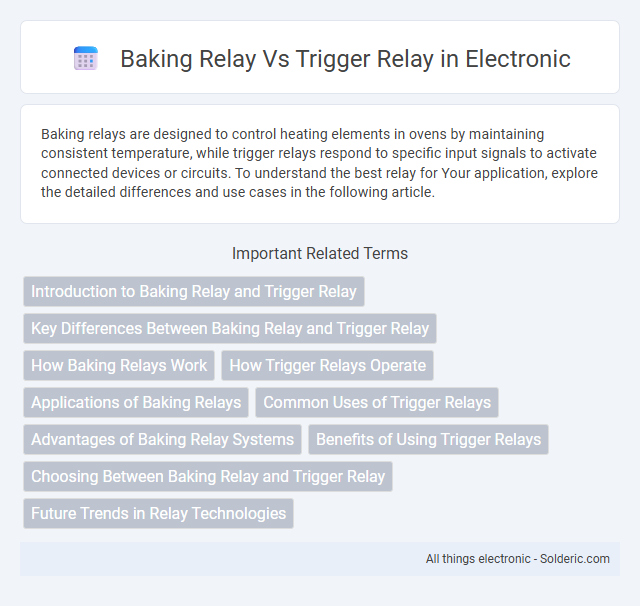Baking relays are designed to control heating elements in ovens by maintaining consistent temperature, while trigger relays respond to specific input signals to activate connected devices or circuits. To understand the best relay for Your application, explore the detailed differences and use cases in the following article.
Comparison Table
| Feature | Baking Relay | Trigger Relay |
|---|---|---|
| Function | Controls heating elements during baking processes | Activates circuits in response to specific signals or inputs |
| Primary Use | Oven and bakery equipment | Industrial automation and signal switching |
| Operation | Maintains heating cycles for consistent temperature | Switches electrical loads upon receiving trigger input |
| Voltage Range | Typically 120-240V AC for heating control | Varies widely; compatible with low to high voltage signals |
| Switching Type | Designed for resistive loads (heaters) | Designed for various loads, including inductive and resistive |
| Response Time | Longer, suitable for thermal control | Fast, suited for quick switching actions |
| Durability | Optimized for heat endurance and stable cycling | Built for frequent switching and signal responsiveness |
| Example Application | Temperature regulation in baking ovens | Start/stop motor control in automation systems |
Introduction to Baking Relay and Trigger Relay
Baking relays and trigger relays serve distinct functions in electrical circuits, each optimized for specific applications. A baking relay is designed to handle higher current loads and maintain steady operation under continuous thermal stress, making it ideal for heating and baking equipment. Trigger relays, in contrast, are sensitive to low voltage signals and are primarily used for initiating circuits or switching with minimal energy input; understanding these differences helps you select the appropriate relay for your project.
Key Differences Between Baking Relay and Trigger Relay
Baking relays are designed to handle high current loads and provide reliable power switching for heating elements in industrial ovens, ensuring precise temperature control. Trigger relays, on the other hand, are optimized for low-voltage control signals that activate circuits without directly managing large power loads. The key difference lies in their application and electrical handling capacity: baking relays focus on robust power delivery for heating systems, whereas trigger relays function primarily as signal initiators in control circuits.
How Baking Relays Work
Baking relays operate by using a resistive heating element that warms the relay coil to maintain a specific temperature, ensuring stable electrical contact during high-temperature processes. This controlled heating prevents contact oxidation and extends relay lifespan in ovens and reflow soldering applications. The precise temperature regulation inherent to baking relays distinguishes them from trigger relays, which rely on instantaneous electrical signals to activate.
How Trigger Relays Operate
Trigger relays operate by instantly switching circuits on or off when a specific voltage or current threshold is reached, enabling rapid and precise control within electrical systems. Unlike baking relays, which are designed for timed heating processes, trigger relays focus on detecting and responding to electrical signals without delay. Your choice of a trigger relay ensures immediate activation or deactivation in safety and automation applications, optimizing performance and reliability.
Applications of Baking Relays
Baking relays are primarily used in applications requiring timed heating control, such as ovens, toasters, and industrial baking equipment, ensuring precise temperature management and safe operation. These relays activate heating elements for specific durations to avoid overheating and optimize energy efficiency. Your baking systems benefit from the reliable timing and temperature stability provided by baking relays, enhancing product quality and safety.
Common Uses of Trigger Relays
Trigger relays are commonly used in automotive applications, industrial machinery, and home automation systems to control high-current circuits with low-current signals. They enable devices like starter motors, lighting systems, and alarm systems to activate reliably and efficiently. Their fast response times and ability to handle frequent switching make them ideal for safety and control mechanisms.
Advantages of Baking Relay Systems
Baking relay systems offer enhanced thermal management and precise temperature control, ensuring consistent baking results and reducing the risk of overheating. These systems improve energy efficiency by cycling power only when necessary, which extends the lifespan of heating elements and lowers operational costs. Your baking process benefits from increased reliability and uniform heat distribution, leading to better product quality and reduced downtime.
Benefits of Using Trigger Relays
Trigger relays offer faster response times and higher precision in controlling electrical circuits compared to baking relays, enhancing system reliability and efficiency. They provide low power consumption and greater durability due to solid-state components, reducing maintenance costs in industrial automation. Their ability to handle high-speed switching makes trigger relays ideal for applications requiring rapid and frequent actuation.
Choosing Between Baking Relay and Trigger Relay
Choosing between a baking relay and a trigger relay depends on the specific electrical application and load requirements. Baking relays are designed for high current switching in appliances like ovens and heaters, providing reliable heat control with durable contacts. Trigger relays excel in low voltage control circuits where fast switching and minimal contact wear are essential, often used in automation and signal processing systems.
Future Trends in Relay Technologies
Future trends in relay technologies highlight the growing integration of smart features and energy-efficient designs in both baking relays and trigger relays, enhancing operational precision and durability. Advances in solid-state components and IoT connectivity enable real-time monitoring and remote control, optimizing relay performance in industrial and consumer applications. Your systems can benefit from these innovations by adopting relays that support predictive maintenance and adaptive switching capabilities.
Baking relay vs trigger relay Infographic

 solderic.com
solderic.com